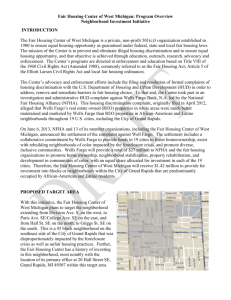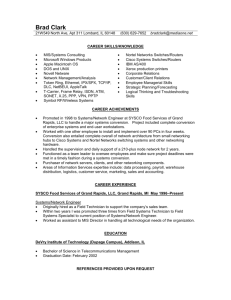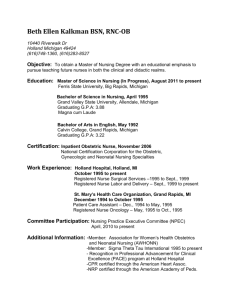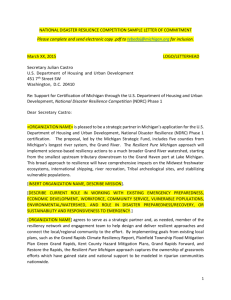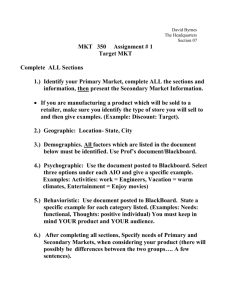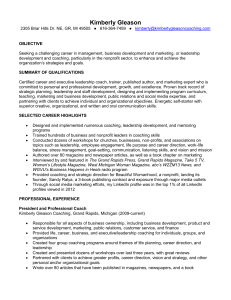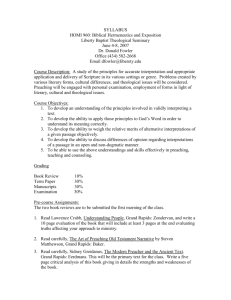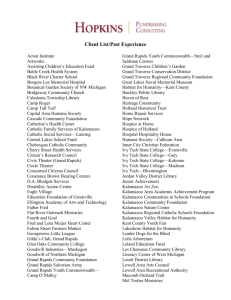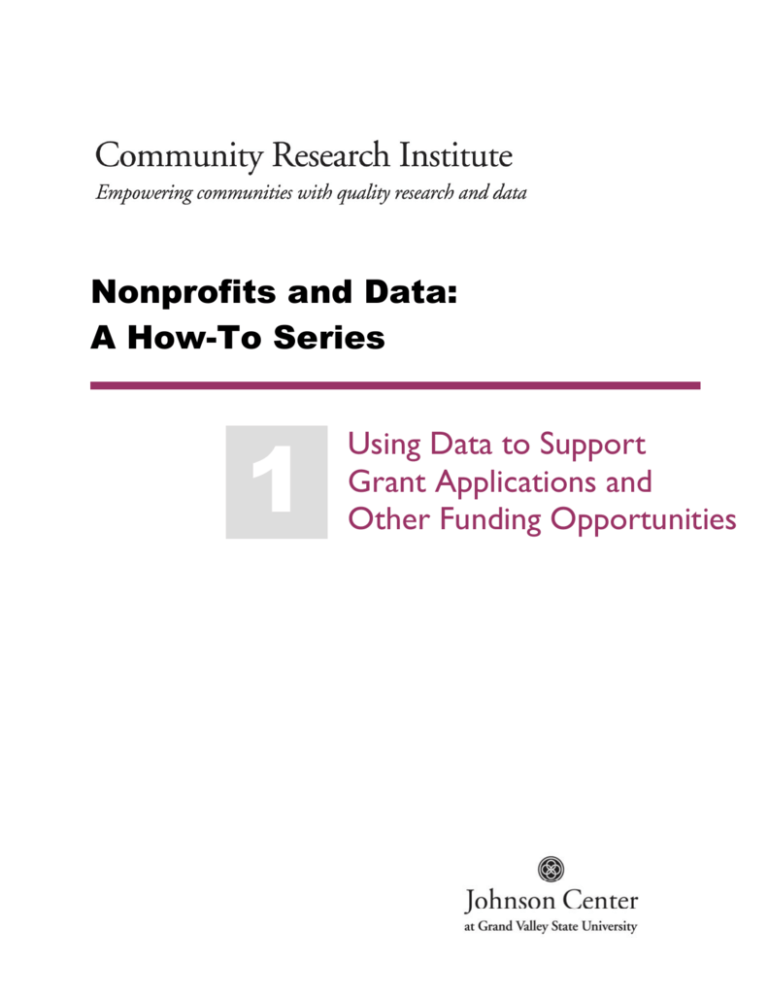
Nonprofits and Data:
A How-To Series
1
Using Data to Support
Grant Applications and
Other Funding Opportunities
ABOUT THE COMMUNITY RESEARCH INSTITUTE
The Community Research Institute (CRI) provides innovative applied research to
West Michigan communities. It empowers communities with quality research
and data, it generates information that will improve their decision-making
process, it forecasts trends for effective problem solving, it measures results and
reports outcomes of investments in community change.
CRI gathers, analyzes, interprets and shares national and local data through
partnerships with nonprofit and neighborhood groups, and assists local and
regional nonprofit leaders with decision making, grant writing, and program
evaluation. This is research that makes a difference through a distinctly valuable
blend of university rigor and community relevance.
Research for this guide was provided by Nicole Notario-Risk and Korrie
Ottenwess.
For additional information visit our website at www.cridata.org or contact us
directly by calling (616)331-7585.
Nonprofits and Data: A How-To Series is available to download at no cost at
www.cridata.org/publications.
Copyright 2004 Community Research Institute - Fair Use Policy
All rights reserved. Materials may be used for educational purposes.
Materials are not to be used or sold for commercial purposes or profit.
-2-
1
Using data to support grant applications
and other funding opportunities
INTRODUCTION
This How-To Series is designed to demonstrate six ways in which data can be
used to enhance the work of nonprofit organizations and community groups.
These include using data to:
1
Support Grant Applications and Other Funding Opportunities
2
Monitor Trends & Identify Emerging Problems
3
Disseminate Information to Engage Community and Policymakers
4
Evaluate Progress in Meeting Goals
5
Establish Priorities and Plan Programs
6
Characterize Disparities Across Sub Populations/Communities
The information contained within each guide has been developed by combining
our community knowledge with that of a variety of grant writing and data
experts. More specifically, within each series installment, you will find an
introduction to the topic, guidelines for using data to achieve the specified
outcome, good practices and pitfalls with corresponding examples, and
resources to find data.
-3-
WHY IS DATA IMPORTANT FOR GRANT APPLICATIONS?
Every good grant proposal contains a needs statement. A needs statement
describes the critical conditions that are affecting certain people or things in a
specific place at a specific time.2 Its purpose is to let funders know what need in
the community your organization is planning to address. “It is the heart of your
entire case for support.2”
Presenting a compelling needs statement is a critical part of the grant proposal.
You connect to a potential funder when they are convinced you both want to
solve the same problem.3 If the funder does not understand or agree that there
is a need for your project then they will lose interest in the rest of your
proposal.2 It is often a convincing needs statement that motivates a funder to
help.
Data in the form of raw numbers, percentages, and ratios give strength to a
needs statement. Specifically, data can be used to answer critical needs
statement questions such as:
•
•
•
•
•
•
•
Who is in need?
Where are they?
When is the need evident?
What is the need?
Why does this need occur?
What are the consequences of meeting the need?
How is the need linked to your organization?
-4-
GUIDELINES FOR USING DATA TO SUPPORT GRANT APPLICATIONS
Part 1 - Gathering Data
There are numerous ways to gather data to support a needs statement. Below
are three basic approaches to get you started. By having a variety of methods of
acquiring supportive data for a needs statement, you will increase your ability to
tailor your proposal.1
Public
Databases
Data can be gathered from public sources such as the U.S. Census
Bureau or from city, county, state or federal government offices. You
will find that many government agencies or departments have large
amounts of data available for public use, including health, housing, or
demographic data. Data from these sources is useful for illustrating
problem areas, showing change over time, and increasing the
understanding of a complex problem. To get started, browse
government agency websites or place an exploratory phone call to the
department that is most closely related to the field your program
addresses. Examples include: Michigan Department of Community
Health, the Center for Disease Control, Michigan Department of
Education, and the Department of Environmental Quality.
Studies
Another approach to finding data is to explore published studies on
your subject. You can look for information in academic journals
which can be accessed through most libraries. Alternately, consult a
local expert at a university. Literature reviews are commonly used to
document the gap between what is and what ought to be.
Surveys
If you cannot find the data that you need to support your case in
existing databases or in published studies, you may want to consider
conducting a survey. A survey can be as simple as a short paper and
pencil feedback form or as complex as an in-depth one-on-one
interview. Surveys can be effective even if you are using a small sample
group or volunteers to administer the survey. To begin, CRI
recommends that you check out a book on developing and
administering surveys.
-5-
Part 2 – Incorporating Data into Grant Proposals
When you begin to use data to answer the ‘who, what, when, where and why’
questions found in a needs statement, there are a few guidelines that should be
followed. Below are some tips gathered from reputable sources in the grant
writing industry.
Avoid using assumptions or undocumented assertions. Documented,
factual statistics will bring fewer questions to your proposal. “There are
few things more embarrassing than to have the funder tell you that your
information is out of date or incorrect. 4”
Use clear statistics that support your argument. It is important to remain
logical and professional in your needs statement. Overstating the problem or
using overly emotional appeals is not suggested.4
Make sure data collection is well documented. It adds credibility to your
statement when you include a reputable source of information. In addition, if the
reader questions your claim, they can go directly to the source to confirm.
Emphasize the geographic area you are designated to serve.
Information that is too generic or broad will not help to clarify the need to the
reader. 4 If you have a survey or local report that backs up your case, it could be
helpful to include it. This shows local
Block
investment and interest in the problem,
Block Group
especially if the study was done by another
3
organization in the community. In addition, a
Census Tract
broad range of data about a community is
Neighborhood
commonly available for large areas such as
cities and counties. Demographic data is
City
available for smaller areas such as
County
neighborhoods and blocks.
MSA
Super-MSA
State
National
-6-
Give a clear sense of the urgency of your request. It can be helpful to
show the reader why the funding is important now or what the consequences
are if the need is not met.2
In any problem statement, include more than one data point. Data is
most likely to have an impact if it is comparative. It is important that the reader
is able to relate it to something. You might consider comparing data over
different time periods (ex: 1990 to 2000), comparing it to the state or national
average, or comparing it to communities that are similar in size or population.
Include relevant history surrounding the problem. If there is a significant
chain of events that has created the problem, then a description of these events
will provide background that significantly contributes to the proposal reviewer’s
knowledge. 3
Add a human touch to your needs statement. Adding stories or case
studies to data can create an effective mix. This type of data can be acquired by
holding public meetings to get testimony on the problem, using quotes from
people who know about the problem or are experts in the field, or using
examples of clients in a need population. Human stories can provide a realistic
picture of what the clients are up against and their need for services.
Don’t forget to give the reader hope. The picture you paint should not be
so grim that the situation appears hopeless. That could cause the reader to
wonder whether an investment in a solution would be worthwhile. For
example, when writing a proposal to fund mammograms for low-income women,
provide mortality statistics relating to cancer AND statistics that prove how
effective early detection can be in surviving breast cancer. 4
-7-
PITFALLS AND GOOD PRACTICES
Using data accurately to support a grant proposal can be tricky. Included below
are several pitfalls to avoid as well as related good practices to keep in mind
when writing your needs statement. These tips were developed from concepts
provided by the Greater New Orleans Community Data Center. After each set
of pitfalls and practices, an example is provided to illustrate its potential use.
PROVIDE DATA FOR THE MOST SPECIFIC LOCATION POSSIBLE
Possible Pitfall
Good Practice
Data that represents geographic
areas larger than the area you are
targeting.
Data that represents the specific
neighborhood(s) or communities where
you are working.
For example...
“In Michigan Public Schools, graduation rates increased 3.4% from 1998 to
2002.”
We can make this statement stronger by including data from the specific school
districts we intend to work with:
“Graduation rates increased 2.4% in Kentmeyer Public School District and
21.5% in Grand Banks Public Schools between 1998 and 2002.”
FOR ADDITIONAL PUBLIC SCHOOL DATA…
VISIT WWW.CRIDATA.ORG OR
WWW.SCHOOLMATTERS.COM
-8-
GATHER THE MOST RECENT DATA AVAILABLE
Possible Pitfall
Good Practice
Data that is outdated and old.
The most recent available data from the
chosen data source.
Putting it to use...
It is important to search out the most current data on your proposal topic. For
instance, Census 2000 data is much more appropriate than 1990 Census data.
Many data sources update their available information every year or two.
ADD PERSPECTIVE BY PROVIDING RAW NUMERS AND
PERCENTAGES
Possible Pitfall
Good Practice
Raw numbers that describe the
problem in your area.
Raw numbers AND percentages that
show the proportion of the total
population in your area that is affected
by the problem.
For example...
“In 2000, 14,628 children lived in female headed households in Grand Rapids.”
By converting the raw number into a percentage, it provides funders some
perspective on the reality of the issue or problem your organization may be
addressing.
“In 2000, 14,628 children lived in female headed households in Grand Rapids.
This number represents 31% of all children under the age of 18.”
FOR ADDITIONAL DATA ON
WEST MICHIGAN’S CHILDREN AND FAMILIES VISIT…
WWW.CRIDATA.ORG OR WWW.MILHS.ORG
-9-
CAREFULLY SELECT THE DATA THAT BEST TELLS YOUR
STORY
Possible Pitfall
Good Practice
All the data you’ve ever found that
relates somewhat to the problem.
Data carefully selected and narrowed
down from the entire list of all the data
you found and presented in a targeted,
compelling, concise problem statement.
Putting it to use...
When an overwhelming amount of data is included in a proposal or needs
statement, it is known as a “data dump5.” While it is important to search
widely for relevant data, it is also important to tailor the data you include in
order to create a crystal clear picture for funders.
INCLUDE DATA THAT IS RELEVANT TO YOUR ISSUE
Possible Pitfall
Good Practice
Data that is not immediately
relevant to the problem
Data that scientific research has
demonstrated is related to the problem
you are addressing
Putting it to use...
If you are writing a proposal to provide pre school educational development
services, it might not be relevant to discuss high school drop out rates in your
needs statement.
If you are writing a proposal to provide prenatal care, you might want to
include data on pregnancy related deaths.
- 10 -
SEARCH OUT REPUTABLE SOURCES
Possible Pitfall
Good Practice
Data from newspapers, magazines,
and TV news programs – sources
that are not in the business of
distributing reliable data.
Data from reputable sources such as
government agencies, nonprofit
associations, and academic or peerreviewed journals.
Putting it to use...
Although it may be tempting to use a snippet from a newspaper or television
program at times when it seems to fit perfectly with your proposal, it is
important to remember that newspapers are in the business of selling
newspapers and television programs are in need of ratings. They may at times
be accurate, but funders may not view those sources as reliable.
For example...
“According to the Peter Jennings on World News Tonight, smoking is the
number one cause of death in the United States “
Instead of citing Peter Jennings as a reference, add credibility to your data by
using a reliable and recognized source such as the Michigan Department of
Community Health (MDCH).
“Data from the MDCH showed tobacco use was the leading cause of death in
2000, killing 435,000 people, or 18.1 percent of everyone who died.”
FOR ADDITIONAL HEALTH DATA VISIT
WWW.CRIDATA.ORG OR WWW.MICHIGAN.GOV/MDCH
- 11 -
TRY TO DESCRIBE THE PROBLEM, NOT YOUR SERVICES
Possible Pitfall
Good Practice
Exclusively including data about the
number of people you serve, the
number of people who are on your
waiting list, and/or the number of
activities you conduct each year.
Data from external sources that point to
the size of the problem in the
community where you are proposing to
work.
Putting it to use...
Waiting lists are often presented as evidence of "need" for a given service in a
given place. However, waiting lists do not capture:
• Whether or not there is another provider with excess capacity within
the same area
• The full extent of the problem in your community
Funders want to know that you have explored referring these clients to
another agency and have established that there is no alternative source of
services for a given client, not just that your agency is unable to provide the
services. In cases such as this, external data can provide an estimate of how
many people in total (not just those on the waiting list) are affected by the
problem.
There are some cases in which it is good to include the number and
demographics of clients your serve. For instance, if you are writing a proposal
to provide additional services to your clients, funders might want to see waiting
list data and client satisfaction data to assess how successful your new services
will be.
For example...
“ln 2002, Helping Hands provided childcare services to 30 families in the Main
Street Neighborhood. 5 remained on the waiting list.”
We can enhance this statement by adding neighborhood level data: “The Main
Street Neighborhood lies in census tracts 15 and 16, where 67% of children
under the age of 12 live in households where both parents are in the
workforce. Helping Hands is currently the only licensed childcare provider
serving those census tracts.”
FOR ADDITIONAL DATA ON NEIGHBORHOODS WITHIN
GRAND RAPIDS & MUSKEGON VISIT WWW.CRIDATA.ORG
- 12 -
USE COMPARISON DATA TO PROVIDE PERCEPTION
Possible Pitfall
Good Practice
Only numbers that represent the
geographic area where you work
without any comparison data
Comparison data from the national level
and other geographic levels of interest to
the funder.
Putting it to use...
If you are writing a program to serve Kent County, one approach for including
comparison data is to include data from neighboring counties such as Muskegon
and Ottawa. Another approach is to include data for other Michigan counties
that contain large cities such as Kalamazoo County or Washtenaw County. A
third approach is to include data showing state and national averages.
For example...
In 1999, the median income in the city of Grand Rapids was $37,224.
We can enhance this statement by adding a graph to show how Grand Rapids
compares to surrounding areas and the state.
Median Household Income
Michigan, Kent County & Grand Rapids 1980-1999
50,000
40,000
Grand Rapids
30,000
Kent County
20,000
Michigan
10,000
0
1979
1989
1999
FOR MORE DEMOGRAPHIC DATA
VISIT WWW.CRIDATA.ORG OR WWW.CENSUS.GOV
- 13 -
WHERE TO BEGIN FINDING DATA
The Community Research Institute (CRI) is working to develop a data
sharehouse for the Greater Grand Rapids community. The concept or
purpose of a data sharehouse is to develop a single integrated system that
can support one-stop data shopping.
To begin exploring community data, visit our website at www.cridata.org.
There you will find county, city, and neighborhood level data. Examples
include:
•
Demographic information on topics such as, population counts,
poverty rates, race, housing and education from the 1990 and
2000 U.S. Census
•
Crime, housing, and voting data from the City of Grand Rapids
•
Data on regional trends including topics such as: Healthy Youth,
Healthy Seniors, Education, Civic Engagement, and Community &
Economic Development, Arts & Culture, Poverty, and
Philanthropy.
•
Various reports on topics that include: the status of women in the
workplace, barriers to success for entry level healthcare workers,
tobacco and smoking cessation programs, violence in Kent
County, employee training needs and practices, communities of
support for the aging population, a the working poor.
It should be noted that CRI has more data than we can fit on our website.
If after reviewing our website, you haven't found what you're looking for
contact Gustavo Rotondaro, GIS/Information Specialist for CRI, for
additional data.
For more information on using data to support grant proposals please
contact, Korrie Ottenwess, Research Manager for the Community Research
Institute at:
Phone:
(616) 331-7585
Email:
Korrie Ottenwess, ottenwko@gvsu.edu
Gustavo Rotondaro, rotondag@gvsu.edu
Web:
www.cridata.org
- 14 -
REFERENCES
1
Bauer, David G. The “How To” Grant Manual: Successful Grantseeking
Techniques for Obtaining Public and Private Grants. Fourth Edition.
1999. Pg 12-15
2
Carlson, Mim. Winning Grants Step By Step. Second Edition. 2002.
Jossey-Bass. Pg 19.
3
Carter New, Cheryl and James Aaron Quick. How to Write a Grant
Proposal. 2003. John Wiley and Sons, Inc. Pgs. 53-60.
4
Geever, Jane C. The Foundation Center’s Guide to Proposal Writing.
Third Edition. 2001. Pg 20.
5
Plyer, Allison. What data do funders want to see in Problem
Statements? Used with permission of the Greater New Orleans
Community Data Center. Retrieved from the www on 12/17/03.
Available at: http://www.gnocdc.org/articles/datafunders.html
- 15 -

